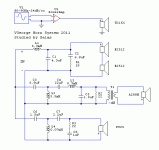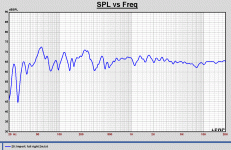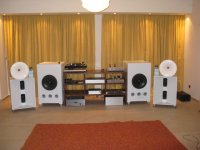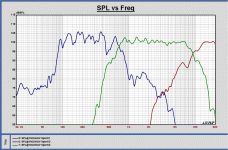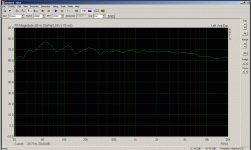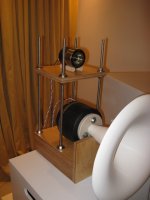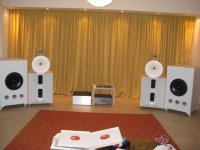My island speakers
After two years of collecting the parts, building a new listening space and finally adjusting the speaker and crossover, I hope that this project came to a near end.
My initial aim was to create something with as much sensitivity, at least above 100Hz, in order to be able to use low wattage tube amplifiers, and at the same time preserving the dynamics of a live orchestra.
The drivers used are GPA 288H 16Ohm with Azura 425 horn, Fostex T925 tweeter and 2x Eminence Deltalite 2512 in a BFM omnitop enclosure. For the lows there is a 290 litter bass reflex tuned to 22Hz with Lambda TD15X 4ohm, crossed actively with CX4300. The 288H are -9dB down with a 3636 Autoformer.
Amplifiers used are a McCormick DNA-1 for the Lambda and an F5 for the all the rest. (OK, there is a plan for a tube amp in the near future)
This project was inspired and influenced by Lynn Olson of course and his thread here in DIYAUDIO.
All the crossover development was done by SALAS, who was very generous with his help. As I live in an island, I was mostly taking measurements and given feedback from him. In fact his help made all the difference. Thanks again Nick.
Below you can see some pictures, the final crossover and a measurement (in room) of the system at 2 meters.
After two years of collecting the parts, building a new listening space and finally adjusting the speaker and crossover, I hope that this project came to a near end.
My initial aim was to create something with as much sensitivity, at least above 100Hz, in order to be able to use low wattage tube amplifiers, and at the same time preserving the dynamics of a live orchestra.
The drivers used are GPA 288H 16Ohm with Azura 425 horn, Fostex T925 tweeter and 2x Eminence Deltalite 2512 in a BFM omnitop enclosure. For the lows there is a 290 litter bass reflex tuned to 22Hz with Lambda TD15X 4ohm, crossed actively with CX4300. The 288H are -9dB down with a 3636 Autoformer.
Amplifiers used are a McCormick DNA-1 for the Lambda and an F5 for the all the rest. (OK, there is a plan for a tube amp in the near future)
This project was inspired and influenced by Lynn Olson of course and his thread here in DIYAUDIO.
All the crossover development was done by SALAS, who was very generous with his help. As I live in an island, I was mostly taking measurements and given feedback from him. In fact his help made all the difference. Thanks again Nick.
Below you can see some pictures, the final crossover and a measurement (in room) of the system at 2 meters.
Attachments
I think I like the sound very much now!
There is presence and dynamics to the music, along with naturalness.
FYI you have to time-align the drivers, especially the tweter were a few milimiters are very important to the final response.
Also, I wouldn't make the bass box so big, but I had them and I have the space.
Also I need to make a proper stand for the horns and the tweeter sometime!
There is presence and dynamics to the music, along with naturalness.
FYI you have to time-align the drivers, especially the tweter were a few milimiters are very important to the final response.
Also, I wouldn't make the bass box so big, but I had them and I have the space.
Also I need to make a proper stand for the horns and the tweeter sometime!
Hi George, Great to see the sytem - looks spectacular - wish I could hear it. And have a swim off that beach. Nice to see the beautiful looking response on the 425 horns - typical Le Cleac'h  Rgds lower mids - do you think there is any possibility of getting a Lambda 15M driver to go up high enough to integrate with teh 425 horns? I am also leaning towards 4 way for this reason.
Rgds lower mids - do you think there is any possibility of getting a Lambda 15M driver to go up high enough to integrate with teh 425 horns? I am also leaning towards 4 way for this reason.
martin
martin
I think you should ditch the midbass cabinets (not sure what a BFM omnitop is but it sure looks like it's aborting the center of the midrange from your measurements) and use the drivers a non-resonant open baffle. Those cabinets look to be wanna be horns, either use a proper straight horn or ditch the funky top and flares.
The mid-bass slots and flares are rugged neighbours to the Le Cleac'h indeed. Here is a 3rd octave that Vgeorge had sent sometime, not sure if its at the 4.5m away sofa but its full room RTA. I hope I will visit to listen to his system myself too sometime in late spring.
Attachments
Rgds lower mids - do you think there is any possibility of getting a Lambda 15M driver to go up high enough to integrate with teh 425 horns? I am also leaning towards 4 way for this reason.
martin
I think that TD15M can easilly integrate with the 425 horns, but you are going to drop the horn around 13 dB. I considered this, but i wanted something more sensitive.
My system efficiency is an estimated 100dB and has an impedance of more than 14Ohm, only droping to 8Ohm on the last octave. This is one reason why I put the 2512 drivers in series. I was getting too low impedance with the drivers parallel. The other was to integrate the level with the tweeter.
Also just found this from Lynn regarding TD15M and 425:
Quote
Both of us wish the efficiency was a bit higher; the horn is being padded down by 13~15 dB, which seems more than a bit wasteful. Three different ways to get the efficiency of the bass module higher would be a short horn, which has uneven response; some kind of folded backhorn on a Lowther-type driver (which also has uneven response); or a quartet of prosound-style 12" drivers in a closed or resistive-vented box. That would get the efficiency in the 70~700 Hz range up beyond 100 dB/metre/watt, and provide better match to the large-format horn.
Quote
Both of us wish the efficiency was a bit higher; the horn is being padded down by 13~15 dB, which seems more than a bit wasteful. Three different ways to get the efficiency of the bass module higher would be a short horn, which has uneven response; some kind of folded backhorn on a Lowther-type driver (which also has uneven response); or a quartet of prosound-style 12" drivers in a closed or resistive-vented box. That would get the efficiency in the 70~700 Hz range up beyond 100 dB/metre/watt, and provide better match to the large-format horn.
George,
Excellent job on the system, I'll bet it sounds fantastic! If you aren't aware of it, have a look at Volvotreter's 77Hz straight conical horn design that was designed in the spirit of Dr. Edgar's straight mid-bass horns. It should be around 104-5db sensitive and a great match to the Azuras.
http://www.volvotreter.de/downloads/Conical_77Hz_Midbass_1.0.pdf
http://www.volvotreter.de/pics_plans.htm
Excellent job on the system, I'll bet it sounds fantastic! If you aren't aware of it, have a look at Volvotreter's 77Hz straight conical horn design that was designed in the spirit of Dr. Edgar's straight mid-bass horns. It should be around 104-5db sensitive and a great match to the Azuras.
http://www.volvotreter.de/downloads/Conical_77Hz_Midbass_1.0.pdf
http://www.volvotreter.de/pics_plans.htm
Last edited:
Thanks for the nice comments!
I am aware of Volvotreter's site. I am considering something like this in the future and there are other threads here doing similar designs right now. I keep an eye on them too.
However it is difficult form me to source the drivers that he uses, so I have to plan something else. I want aslo to have a nice response until 1kHz, in order to be easy on the crossover. Most designs I see, cross around 500Hz and have poor response and directivity above that.
It' s also better to stay around the 100db mark, so I do not have to change the super tweeters, that despite their specifications, they measure lower in sensitivity.
I am aware of Volvotreter's site. I am considering something like this in the future and there are other threads here doing similar designs right now. I keep an eye on them too.
However it is difficult form me to source the drivers that he uses, so I have to plan something else. I want aslo to have a nice response until 1kHz, in order to be easy on the crossover. Most designs I see, cross around 500Hz and have poor response and directivity above that.
It' s also better to stay around the 100db mark, so I do not have to change the super tweeters, that despite their specifications, they measure lower in sensitivity.
Being clever when using a tube amp
If you go with tube amps, for the midrange and tweeter, I would use a capacitor coupled tube amp and size the coupling capacitor to replace the need for one of your highpassing capacitors in series with the midrange drivers. Or, you could use a parallel feed style design and you could size both the coupling and parafeed capacitors to replace both capacitors in series with your midrange drivers (although you would need to design the parallel feed capacitor to avoid a bump below the crossover frequency). That will help the quality of your midrange.
Retsel
If you go with tube amps, for the midrange and tweeter, I would use a capacitor coupled tube amp and size the coupling capacitor to replace the need for one of your highpassing capacitors in series with the midrange drivers. Or, you could use a parallel feed style design and you could size both the coupling and parafeed capacitors to replace both capacitors in series with your midrange drivers (although you would need to design the parallel feed capacitor to avoid a bump below the crossover frequency). That will help the quality of your midrange.
Retsel
Retsel,
thank you very much for the advise.
My plan is to first build a Baby Huey to use from 100hz.
And later a dedicated SET channel for the upper horns. As for the parafeed design, I need to gain more experience in tube building first! Also I think that a capacitor would be needed for the safety of the diaphragms.
Anyway, being too busy now with work. All these have to wait until October, when I am going to have more free time.
thank you very much for the advise.
My plan is to first build a Baby Huey to use from 100hz.
And later a dedicated SET channel for the upper horns. As for the parafeed design, I need to gain more experience in tube building first! Also I think that a capacitor would be needed for the safety of the diaphragms.
Anyway, being too busy now with work. All these have to wait until October, when I am going to have more free time.
Capacitors in tube amps
Right, you need to high pass the horns and right now you are doing that with large capacitors in series with your drivers. My point is that you can do the same thing using capacitors in your amps and then eliminate the capacitors in series with your drivers. The capacitors in your amps will be much smaller and therefore can be of better quality than the large ones in the speaker crossover.
The other benefit, by placing the crossover capacitor before your output tube, is you take out the need for the output tube to reproduce bass which will allow the amp to do a lot better job with the higher frequencies.
Retsel
Right, you need to high pass the horns and right now you are doing that with large capacitors in series with your drivers. My point is that you can do the same thing using capacitors in your amps and then eliminate the capacitors in series with your drivers. The capacitors in your amps will be much smaller and therefore can be of better quality than the large ones in the speaker crossover.
The other benefit, by placing the crossover capacitor before your output tube, is you take out the need for the output tube to reproduce bass which will allow the amp to do a lot better job with the higher frequencies.
Retsel
How nice, well done!
And, as the speakers are mostly built as 'modules', then there're chances to try some experiments. For example, the outrageous OSD:
http://www.diyaudio.com/forums/multi-way/180301-lq-osd-acoustic-alternative.html

And, as the speakers are mostly built as 'modules', then there're chances to try some experiments. For example, the outrageous OSD:
http://www.diyaudio.com/forums/multi-way/180301-lq-osd-acoustic-alternative.html
- Status
- This old topic is closed. If you want to reopen this topic, contact a moderator using the "Report Post" button.
- Home
- Loudspeakers
- Multi-Way
- My island speakers
